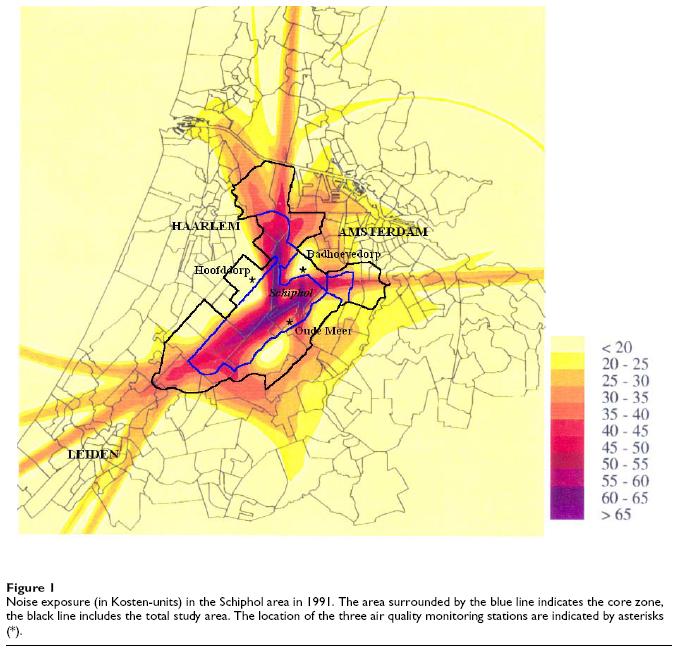Noise levels around the Schiphol airport
| Moderator:Erkki Kuusisto (see all) |
|
|
| Upload data
|
Contents
Scope
Noise levels describes the noise levels around the Schiphol airport in the Netherlands.
Description
These contents are from EUROCONTROL
Above certain noise levels (if it is too quiet measurement can become inaccurate), the noise levels on the ground from aircraft operations can be measured using carefully sited, purpose designed microphones. This is particularly useful to measure how an aircraft is being flown. Because of the effects of factors such as ambient noise and weather, individual measurements only give a snapshot assessment and do not always reflect the average situation. For this reason measurement is most often used in assessing operational performance rather than overall noise impact. To reach an understanding of average noise levels, noise is usually modelled using computer programmes that simulate aircraft “virtually” following an airports operating procedures, but with suitable variability such as track dispersion to make it more realistic. These models, such as the widely used “International Noise Model”, produce aircraft noise footprints for the number of and type of aircraft using an airport in order to calculate the extent of particular noise levels around the airport. This will assume average weather conditions. These noise “contours” can then be placed on a map to see which communities are subjected to different degrees of average noise levels. But it should be remembered that, as average conditions rarely occur, the noise contours are only indicative of typical noise impact.
Integrated Noise Model (INM) is a tool for estimating noise level in the surroundings of airports. It is used to produce noise exposure maps (NEM)
Noise management measures
- reduction of aeroplane noise at source
- land-use planning and management measures
- noise abatement operational procedures
- operating restrictions
- establishing a technical partnership between airport air traffic control, aircraft operators and the airport operator to jointly progress aircraft noise management
- depicting preferred noise routes on a map that avoid residential areas as far as possible, monitoring track adherence accuracy and seeking to improve track-keeping
- avoiding over-flying sensitive sites such as hospitals and schools
- ensuring that the optimum runway(s) and routes are used as far as conditions allow
- using continuous descent approaches and departure noise abatement techniques
- avoiding unnecessary use of auxiliary power units by aircraft on-stand
- building barriers and engine test-pens to contain and deflect noise
- towing aircraft instead of using jet engines to taxi
- limiting night operations
- limiting the number of operations or the extent of a critical noise contour
- providing noise insulation for the most severely affected houses
- applying different operational charges based on the noisiness of the aircraft
- monitoring individual noise levels and penalising any breach
Kosten unit (Ke): a unique, Dutch measure for the annual average noise from air traffic around airports, which 'adds up' the peak levels from all flights. It includes only those flights that generate peak levels in excess of 65 dB(A). The use of a threshold value of 65 dB(A) to calculate Kosten Units results in the exclusion of an increasing number of movements. At slightly larger distances from Schiphol Airport, where more but quieter airplanes fly over, the observed noise exposure in Ke appeared to decrease more than has now proven to be the case on the basis of the equivalent noise level. Ke values cannot be converted directly into Lden values, however, the Lden value is approximately equal to (0.5*Kosten unit+41) (Dassen et al. (2000) in Franssen et al. (2004)). 35 and 20 Ke correspond approximately to 58 and 53 dB(A) Lden respectively; 20 and 26 LAeq to approximately 41 and 49 dB(A) Lnight respectively.
Lden: 'Lday-evening-night'. An equivalent noise unit, which gives a higher weighting for noise in the evening and at night than for noise during the day. A threshold value is not used. The Lden is set out in an EU directive for ambient noise for the appraisal of noise from road and rail traffic, aviation and industry.
dB(A): The A-weighted decibel value - dB(A) - is the most common unit of noise measurement. The A-weighting takes into account the sensitivity of the human ear to pitch. Halving or doubling the noise sources corresponds to 3 units. People experience a decrease or increase of 10 units of noise exposure as respectively a halving or doubling of the volume of the noise. A selection of values: - 40 dB(A): natural background level; maximum value for noise abatement zones; - 50 dB(A): noise in a quiet residential street; - 70 dB(A): noise of an average main road at a distance of 10 metres.
References
- Otto Visser, Joop H van Wijnen and Flora E van Leeuwen: Incidence of cancer in the area around Amsterdam Airport Schiphol in 1988–2003: a population-based ecological study. BMC Public Health 2005, 5:127 doi:10.1186/1471-2458-5-127
Definition
Causality
List of parents:
Data
Formula
Analytica_id:
<anacode></anacode>

